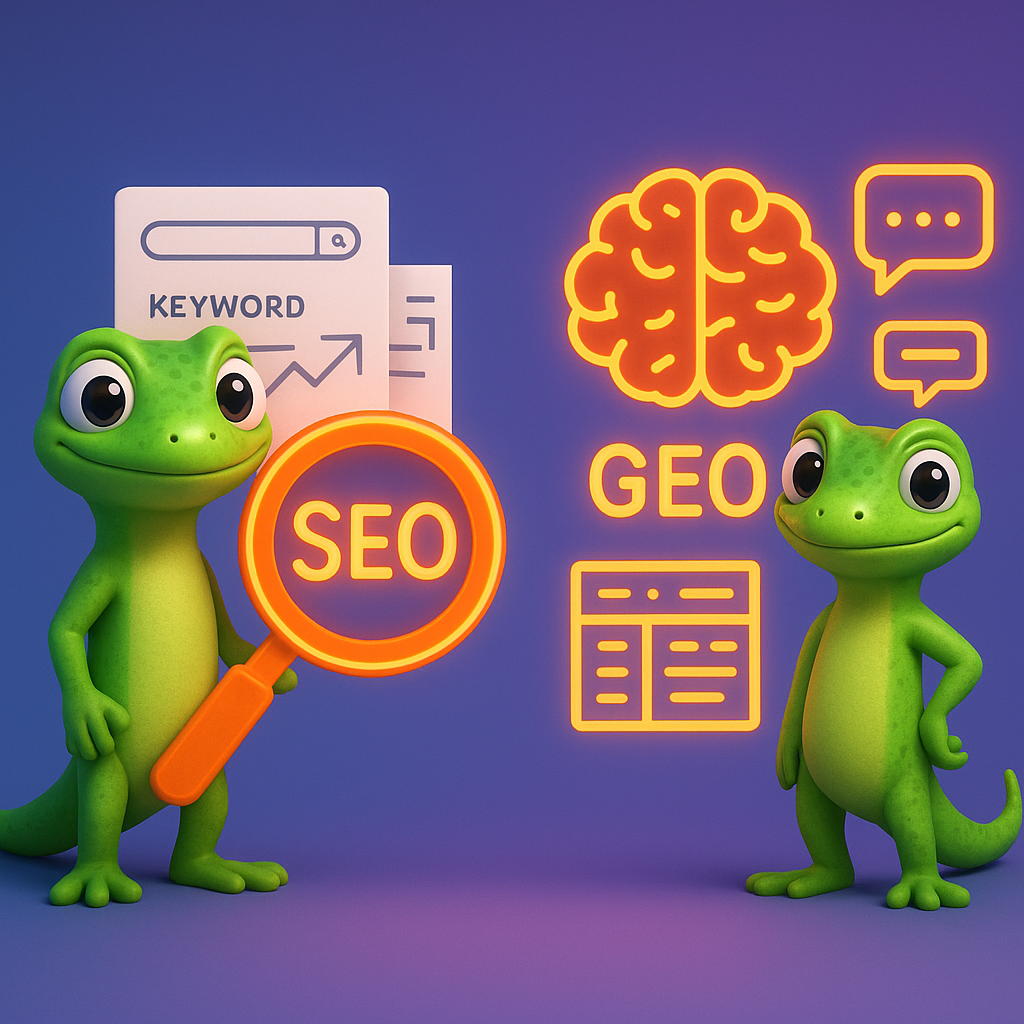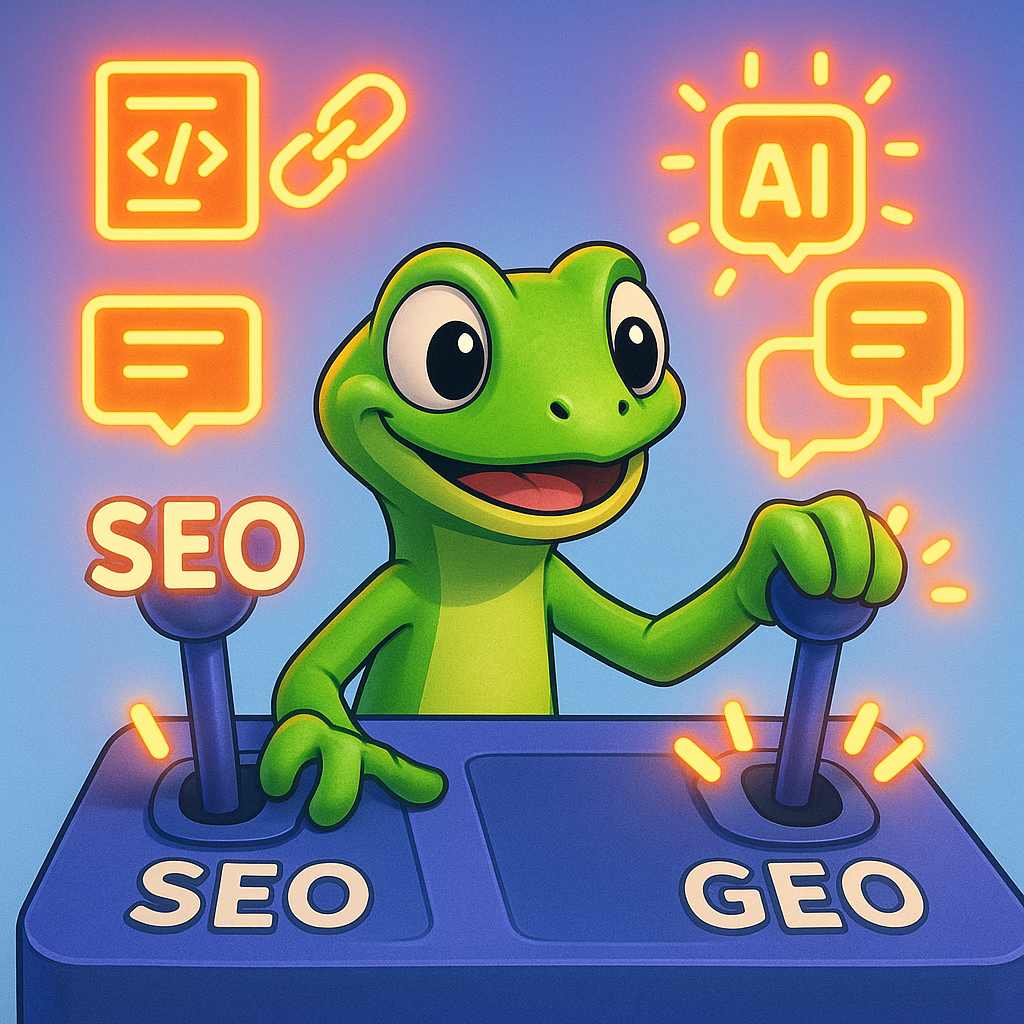SEO vs GEO: Key Differences for Optimized Content Strategy
The digital marketing landscape is witnessing a fundamental shift in how content is discovered and consumed. While traditional SEO remains vital, the rise of AI-powered search platforms has created a new optimization frontier: Generative Engine Optimization (GEO).
What Are SEO and GEO?
SEO (Search Engine Optimization) focuses on optimizing content for traditional search engines like Google and Bing. It relies on keywords, backlinks, technical optimization, and on-page elements to rank in search engine results pages (SERPs).
GEO (Generative Engine Optimization) targets AI-driven platforms such as Perplexity, ChatGPT, and Google’s AI features. It prioritizes structured, factual content and natural language to have content cited in generative responses rather than just appearing in ranked lists.

Core Differences Between SEO and GEO
| Aspect | SEO | GEO |
|---|---|---|
| Primary Target | Traditional search rankings | AI-generated answers/citations |
| Content Focus | Keyword density, backlinks, technical SEO | Structured data, conversational queries |
| KPIs | Rankings, organic traffic | Citation frequency, AI-referred traffic |
| Growth Rate | 5.6% YoY (stable) | Tied to AI adoption (emerging) |
According to industry research, 65% of marketers are now adapting their strategies to account for AI-generated search results. This highlights the growing importance of GEO in modern digital marketing strategies.
How SEO Works: The Traditional Approach
Traditional SEO relies on several key mechanisms:
- Keyword Research: Identifying high-volume, relevant search terms (e.g., “best CRM software”)
- On-Page Optimization: Implementing meta tags, headers, and alt text
- Technical SEO: Ensuring site speed, mobile-friendliness, and crawlability
- Backlink Acquisition: Building domain authority through quality links
SEO continues to drive 53% of website traffic globally and maintains a stable growth rate of 5.6% year-over-year. Despite the rise of AI search, traditional SEO remains foundational for online visibility.
The traditional SEO approach is like building a road map for search engines - you’re creating clear signs and directions that help algorithms understand what your content is about and why it deserves to rank highly.
How GEO Works: The AI-Driven Approach
GEO employs different techniques to optimize for AI platforms:
- AI-Driven Content Creation: Using prompt engineering tactics to generate content that matches AI expectations
- Structured Data Markup: Implementing schema to help AI extract information
- Factual Accuracy: Ensuring content meets E-E-A-T standards to enable AI citations
- Conversational Format: Creating question-answer structures that match how people interact with AI
As Marion.com notes, “GEO reframes SEO goals: instead of ranking on a page of links, content may be quoted by AI.” This shift requires a fundamental rethinking of content strategy.
Think of GEO as preparing your content to be a helpful expert that an AI can consult and quote when answering questions. Rather than optimizing to be found, you’re optimizing to be cited and referenced.
Impact on Localized and Global Search Performance
Localized Impact
GEO can significantly enhance localized content performance by:
- Optimizing for conversational local queries (e.g., “best pizza near me”)
- Structuring location-based information for easy AI extraction
- Providing contextual local information that AIs can cite in responses
For example, a healthcare provider might combine structured FAQs (for AEO), comprehensive content (for SEO), and clinically verified data (for GEO) to maximize visibility across all search interfaces. When a user asks an AI assistant about “dermatologists in Chicago who specialize in eczema treatment,” well-structured content with verified credentials is more likely to be cited.
Global Reach
For global strategies, the SEO-GEO combination offers powerful synergies:
- SEO drives broad keyword rankings for international audiences
- GEO ensures content gets cited in AI responses regardless of language or location
- Content can be strategically repurposed from comprehensive SEO formats into structured GEO formats
A multinational company might create in-depth guides (SEO) that contain clear data tables and fact-based sections (GEO) to capture both traditional search traffic and AI citations across different markets.
How SEO and GEO Work Together
Rather than choosing between SEO and GEO, marketing leaders should implement an integrated approach:
- Layered Content Strategy: Start with traditional keyword-optimized foundations, then expand with GEO elements like topic clusters and conversational writing
- Dual Optimization Workflow: Apply technical SEO audits alongside semantic and intent-based content enhancements
- Content Repurposing: Update existing high-ranking SEO content for AI-readiness with schema and conversational elements
- Comprehensive Measurement: Track both traditional SEO metrics and new GEO metrics like AI citations and referrals
Organizations implementing this integrated approach have achieved 15-20% increases in featured snippet captures and more consistent AI brand mentions.

Consider the case of a financial services company that restructured their retirement planning guides to include both keyword-rich narrative content (SEO) and clearly structured, factual tables comparing investment options (GEO). The result was maintaining their Google rankings while also being frequently cited by AI assistants answering questions about retirement planning strategies.
Strategic Implications for Marketing Leaders
Resource Allocation
Different optimization approaches require distinct resources:
- SEO: Requires ongoing keyword research and technical audits
- GEO: Demands structured content creation and AI citation tracking
Marketing leaders need to evaluate their current team composition and potentially invest in new skill development or technology to effectively optimize for both approaches.
Skill Requirements
Teams need expanded skillsets:
- SEO: Technical SEO expertise, backlink strategies
- GEO: Prompt engineering, data structuring, AI tool proficiency
Many organizations are cross-training their content teams in both disciplines, recognizing that the skills are complementary rather than competitive. Some teams are creating hybrid roles specifically focused on content optimization across both traditional and AI search environments.
Content Workflows
Efficient content production requires:
- Layered content development (direct answers + detailed information)
- Sector prioritization (e.g., GEO for SaaS, SEO for e-commerce)
Successful content teams are implementing planning frameworks that address both SEO and GEO requirements from the outset, rather than retrofitting content after publication.
Is GEO Replacing SEO?
No, GEO is not replacing SEO—it’s complementing it. While traditional search still accounts for 95.7% of search traffic, AI-mediated search is growing rapidly. As LLM search adoption increases, marketing leaders must balance both approaches.
According to ContentGecko research, the most successful content strategies in 2024 combine proven SEO fundamentals with comprehensive, context-driven GEO techniques, leveraging both to build cohesive, future-ready digital marketing programs.
The relationship between SEO and GEO is similar to how mobile optimization complemented desktop optimization rather than replacing it. Just as marketers needed to adapt to mobile-first indexing while maintaining desktop optimization, today’s marketers need to embrace GEO while continuing their SEO efforts.
Tools for Optimizing Both SEO and GEO
Several tools can help marketers optimize for both traditional and AI search:
- Keyword Clustering Tools: Free keyword grouping tools help identify semantic relationships between terms
- AI Content Writers: Content writing generators that understand both SEO and GEO principles
- ROI Calculators: SEO ROI calculators that can measure the combined impact of SEO and GEO
- Performance Monitoring: Tools for tracking LLM visibility and citations
Integrated platforms like ContentGecko are emerging to provide comprehensive optimization across both traditional and AI-driven search environments, helping marketers manage the increasing complexity of the search landscape.
TL;DR
SEO and GEO represent complementary approaches to content optimization. While SEO focuses on traditional search rankings through keywords and technical factors, GEO targets AI-generated answers through structured, factual content. The most effective digital strategies combine both approaches, using SEO for broad visibility and GEO for AI citations.
As AI continues reshaping the search landscape, marketers must develop integrated content strategies that work across both traditional and generative search interfaces. By understanding the unique mechanisms and requirements of each approach, marketing leaders can maximize organic visibility and traffic in an increasingly AI-mediated digital ecosystem.
